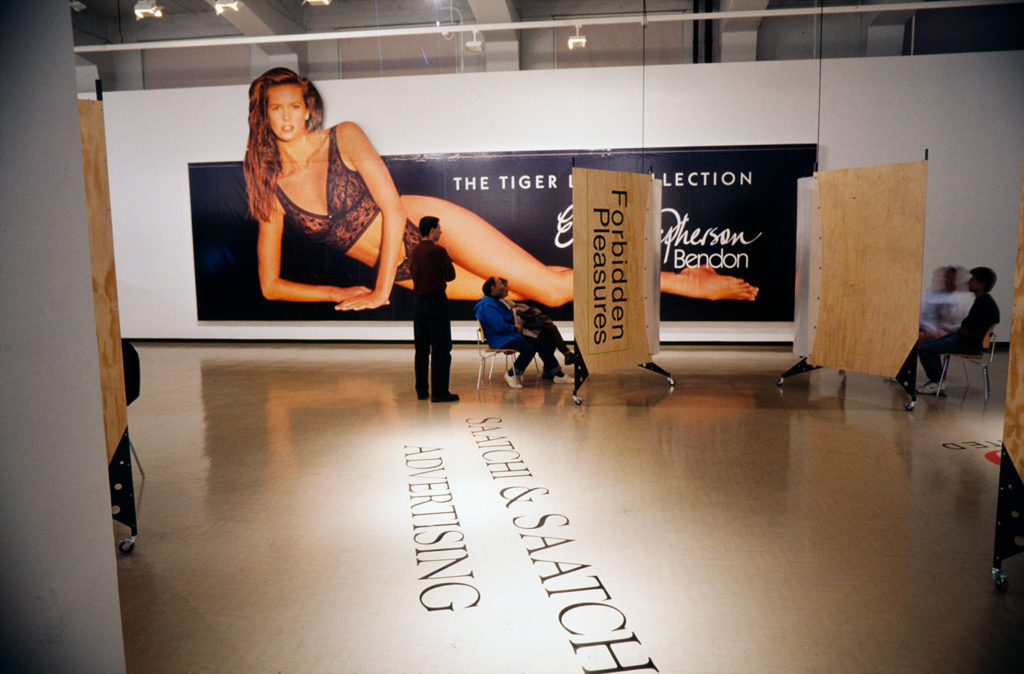CURATORS Stuart McKenzie, Neil Pardington OTHER VENUES Waikato Museum of Art and History, Hamilton, 11 March–21 May 1995; Aigantighe Art Gallery, Timaru, 30 June–30 July 1995; Otago Settlers Museum, Dunedin, 1 December 1995–25 February 1996; Manawatu Art Gallery, Palmerston North, 15 March–15 May 1996; Gus Fisher Gallery, Auckland, 21 June–21 July 1996 SPONSORS Saatchi and Saatchi, Lintas, Colenso
On commercial television, the high quality of the entertainment is often spoiled by those annoying little interruptions, which we call programmes.—Kenneth Horne
Selling New Zealand presents ‘the official art of capitalism’—advertisements. In the accompanying pamphlet, curators Stuart McKenzie and Neil Pardington insist ‘a society without ads is like a restaurant without menus’. Over two-hundred TV ads are shown on eight monitors. They are organised into ten loose themes: ‘Family Ties’, ‘Games People Play’, ‘Godzone’, ‘Great Big Melting Pot’, ‘Forbidden Pleasures’, ‘Hard Yakka’, ‘Kiwi Icons’, ‘The Latest in Latest Things’, ‘Squeaky Clean’, and ‘Stereotypes’.
‘Family Ties’ considers representations of the New Zealand family, while ‘Great Big Melting Pot’ addresses New Zealand’s unique cultural identity, addressing, in particular, notions of biculturalism. For example, a 1970s Bic ad shows a Pākehā man unsuccessfully trying to light a camp-fire. As his female partner shivers beside him, a group of Māori men threateningly emerge from the bush around them. One of them then produces a Bic lighter, and the group enjoy the fire together.
‘Games People Play’ considers our unrelenting obsession with sport. ‘Kiwi Icons’ presents definitely ‘kiwi’ personalities and products. ‘Squeaky Clean’ looks at common notions of health—‘physical, religious, or political’. ‘Hard Yakka’ addresses the work-and-leisure ethic. This is best expressed in a two-part Greggs coffee ad from the 1970s. The first part depicts a cross-section of the New Zealand working class, working hard and ‘seeing the job through’ with the help of Greggs coffee. The second part depicts their downtime, still enjoyed with a satisfying Greggs coffee. ‘The Latest in Latest Things’ focuses on fashion and the fast pace of consumer culture. ‘Forbidden Pleasures’ examines the changing brief for socially acceptable pleasures.
‘Godzone’ investigates the imaging of New Zealand as a mythic paradise and land of opportunity. Toyota’s Welcome to Our World ad pivots on national stereotypes—the highland sheep herder, the bohemian coffee drinker, the fisherman, Māori elders engaged in a hongi, Māori women dancing with poi, girls performing ballet, an elderly couple walking on a beach, and the trusty Toyota car. Considering it was made in the same year as the show, its inclusion (along with others’) ensures the show is a reflection not just of the past, but also of the present.
The show is dressed. A billboard for Bendon Lingerie—featuring Elle Macpherson—dominates one space. Another billboard, for Isuzu Motors, depicts a cow propelled by wheels—‘NZ’s Favourite Milk Truck’. In the corner of the room is a showcase of common supermarket products, including Weet-Bix, Ajax cleaner, Anchor butter, Steinlager beer, Johnson’s baby powder, and Raro drink. A reminder accompanies them: ‘All of these products available at New World, Wellington City.’ Many of the products feature in the ads. The names of the three advertising giants sponsoring the show—Colenso, Lintas and Saatchi & Saatchi—are printed across the floor.
The reception of Selling New Zealand as an art exhibition is varied. Some praise its originality. Others believe it gives advertisers yet another chance to reach viewers in a sacred space that should be reserved for proper art and artists. As one Sunday Star Times review claims: ‘This show is another part of what seems to be a plan to sanctify the advertising industry, to somehow divorce advertising from its greedy soul by investing it with social values more worthy than its profit motif suggests … Here there are no artists, and we are told nothing, shown nothing that is tangible. But that, I guess, is advertising.’
Interestingly, the curators predict that, one day, viewers will be able to stop ads from playing on their screens. In the ‘skip ad’ world we live in today, where our screens are governed by taste-detecting algorithms, this has become reality.



































































































